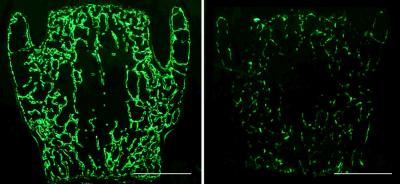New research shows that the Wnt receptor Frizzled-9 (Fzd9) promotes bone formation, providing a potential new target for the treatment of osteoporosis. The study appears online on March 14 in The Journal of Cell Biology (www.jcb.org).
Adult bones are maintained by a balance of bone-forming osteoblasts and bone-resorbing osteoclasts. Although Wnt signaling affects this balance in mice and humans, the Wnt receptors involved remain unknown. A team of researchers led by Thorsten Schinke found that the Wnt receptor Fzd9 was upregulated during osteoblast differentiation and that mice lacking Fzd9 had fragile bones due to low rates of bone formation.
Fzd9-null osteoblasts differentiated normally, but they failed to mineralize their extracellular matrix. The loss of Fzd9 disrupted a non-canonical branch of the Wnt signaling pathway, resulting in reduced levels of the transcription factor STAT1, which was, in turn, required for the expression of several interferon-regulated genes. One of these genes en-coded a ubiquitin-like molecule called Isg15. Though little is known about Isg15's function, restoring its expression in Fzd9-null osteoblasts boosted matrix mineralization, whereas mice lacking Isg15 had similar bone defects to Fzd9-knockout animals.

Compared to wild-type (left), a vertebra from a Fzd9-null mouse (right) shows reduced calcein staining (green), indicating a decreased rate of bone formation.
(Photo Credit: Albers, J., et al. 2011. J. Cell Biol. doi:10.1083/jcb.201008012)
Mice lacking one copy of Fzd9 also had low bone mass, suggesting that insufficient Fzd9 may cause the reduced bone density seen in Williams-Beuren syndrome patients, who have a hemizygous deletion of the chromosomal region that includes the FZD9 gene. Schinke now wants to investigate whether boosting Fzd9 expression has the opposite effect to Fzd9 depletion and can stimulate bone formation. If so, Fzd9 would be an attractive drug target for treating a variety of bone-loss disorders.
Source: Rockefeller University Press